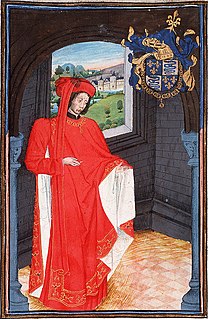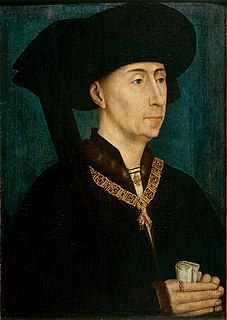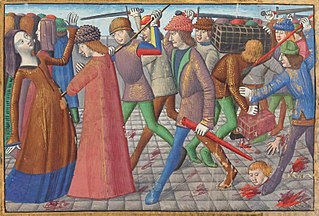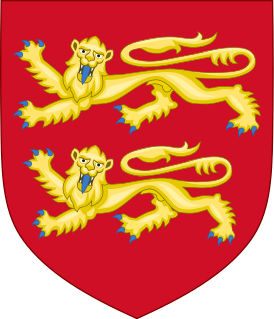Year 1419 (MCDXIX) was a common year starting on Sunday of the Julian calendar.

Philip II the Bold was Duke of Burgundy and jure uxoris Count of Flanders, Artois and Burgundy. He was the fourth and youngest son of King John II of France and Bonne of Luxembourg.

Charles VII, called the Victorious or the Well-Served, was King of France from 1422 to his death in 1461.

Charles of Orléans was Duke of Orléans from 1407, following the murder of his father, Louis I, Duke of Orléans. He was also Duke of Valois, Count of Beaumont-sur-Oise and of Blois, Lord of Coucy, and the inheritor of Asti in Italy via his mother Valentina Visconti.

Philip III was Duke of Burgundy from 1419 until his death. He was a member of a cadet line of the Valois dynasty, to which all 15th-century kings of France belonged. During his reign, the Burgundian State reached the apex of its prosperity and prestige, and became a leading centre of the arts. Philip is known historically for his administrative reforms, his patronage of Flemish artists such as van Eyck and Franco-Flemish composers such as Guillaume Du Fay, and perhaps most significantly the seizure of Joan of Arc, whom Philip ransomed to the English after his soldiers captured her, resulting in her trial and eventual execution. In political affairs, he alternated between alliances with the English and the French in an attempt to improve his dynasty's powerbase. Additionally, as ruler of Flanders, Brabant, Limburg, Artois, Hainaut, Holland, Luxembourg, Zeeland, Friesland and Namur, he played an important role in the history of the Low Countries.

John I was a scion of the French royal family who ruled the Burgundian State from 1404 until his death in 1419. He played a key role in French national affairs during the early 15th century, particularly in the struggles to rule the country for the mentally ill King Charles VI, his cousin, and the Hundred Years' War with England. A rash, ruthless and unscrupulous politician, John murdered the King's brother, the Duke of Orléans, in an attempt to gain control of the government, which led to the eruption of the Armagnac–Burgundian Civil War in France and in turn culminated in his own assassination in 1419.

Isabeau of Bavaria was Queen of France between 1385 and 1422. She was born into the House of Wittelsbach as the only daughter of Duke Stephen III of Bavaria-Ingolstadt and Taddea Visconti of Milan. At age 15 or 16, Isabeau was sent to the young King Charles VI of France; the couple wed three days after their first meeting.
The Armagnac faction was prominent in French politics and warfare during the Hundred Years' War. It was allied with the supporters of Charles, Duke of Orléans against John the Fearless after Charles' father Louis of Orléans was killed on a Paris street on the orders of the Duke of Burgundy on 23 November 1407.

The Cabochien revolt was an episode in the civil war between the Armagnacs and the Burgundians which was in turn a part of the Hundred Years' War.

The House of Normandy designates the noble family which originates from the Duchy of Normandy and whose members were counts of Rouen, dukes of Normandy, as well as kings of England following the Norman conquest of England. It lasted until the House of Plantagenet came to power in 1154. The house emerged from the union between the Viking Rollo and Poppa of Bayeux, a West Frankish noblewoman. William the Conqueror and his heirs down through 1135 were members of this dynasty.

William II of Bavaria was duke of Bavaria-Straubing and count of Holland, Hainaut and Zeeland. He ruled from 1404 until 1417, when he died from an infection caused by a dog bite.

John III the Pitiless (1374–1425), of the House of Wittelsbach, was first bishop of Liège 1389–1418 and then duke of Bavaria-Straubing and count of Holland and Hainaut 1418–1425.

Margaret of Bavaria was the duchess of Burgundy by marriage to John the Fearless. She was the regent of the Burgundian Low Countries during the absence of her spouse in 1404–1419 and the regent in French Burgundy during the absence of her son in 1419–1423. She became most known for her successful defense of the Duchy of Burgundy against Count John IV of Armagnac in 1419.

The Armagnac–Burgundian Civil War was a conflict between two cadet branches of the French royal family — the House of Orléans and the House of Burgundy from 1407 to 1435. It began during a lull in the Hundred Years' War against the English and overlapped with the Western Schism of the papacy.

John the Fearless, Duke of Burgundy, was assassinated on the bridge at Montereau on 10 September 1419 during a parley with the French dauphin, by Tanneguy du Chastel and Jean Louvet, the dauphin's close counsellors.
Events from the year 1407 in France
Events from the year 1419 in France.